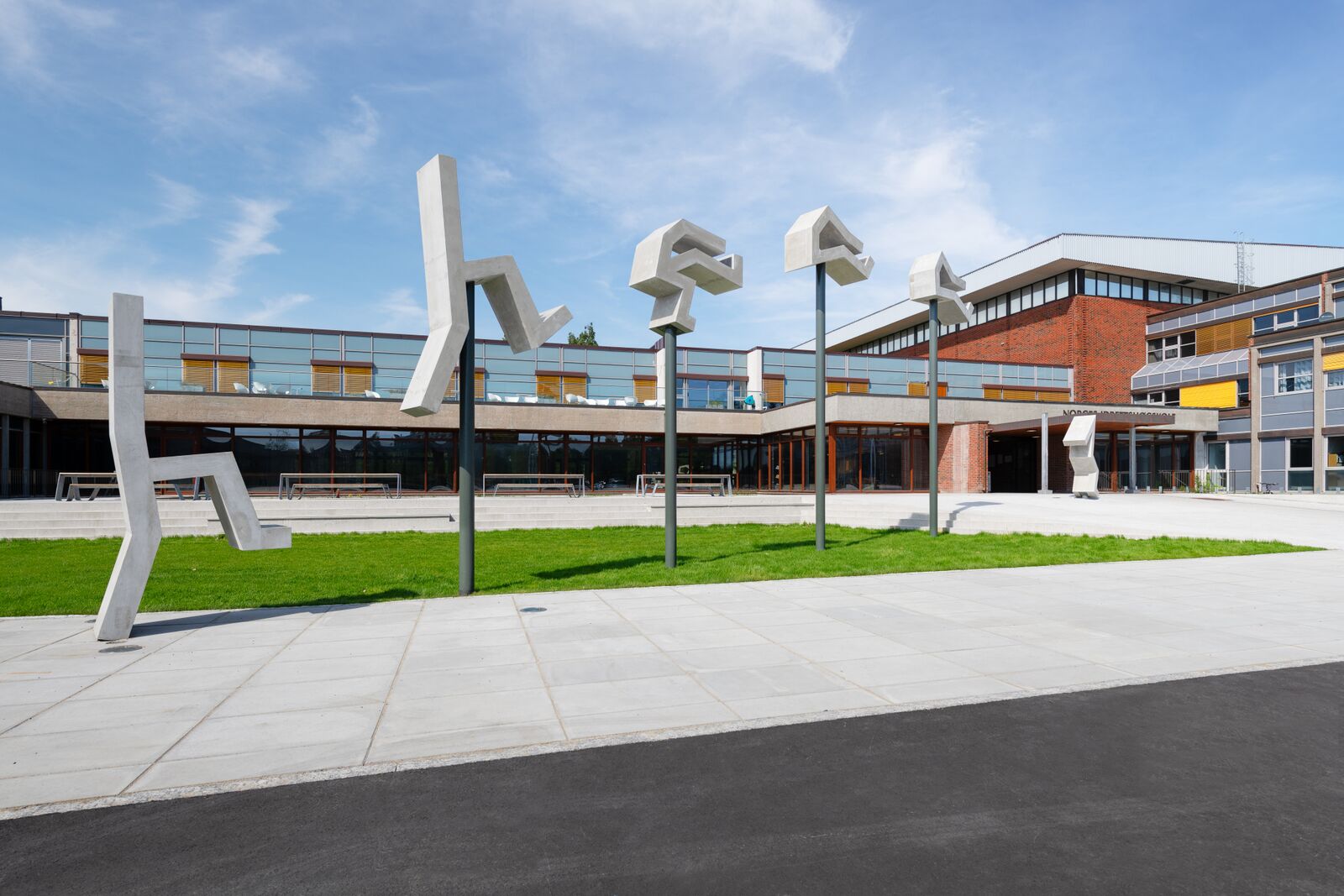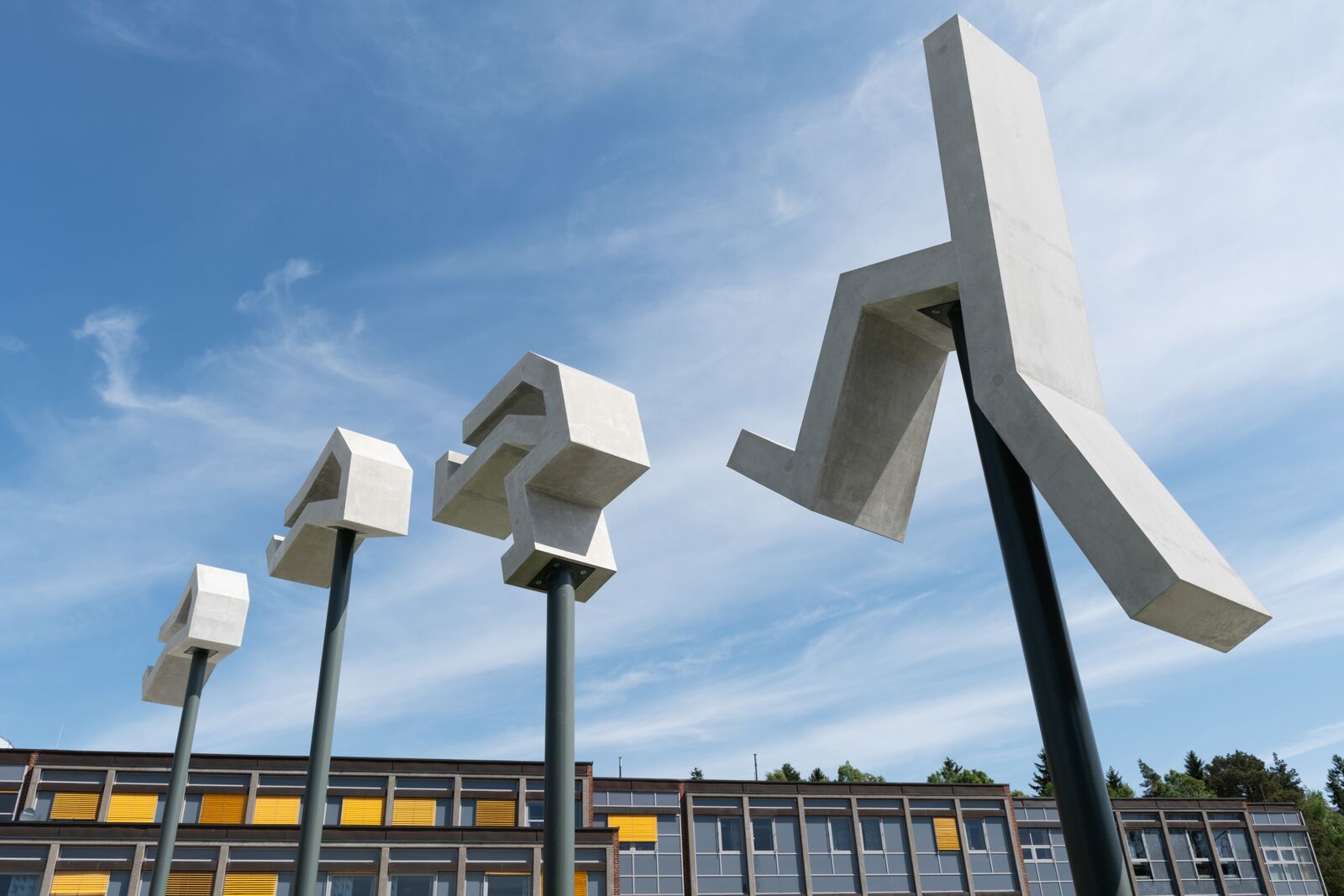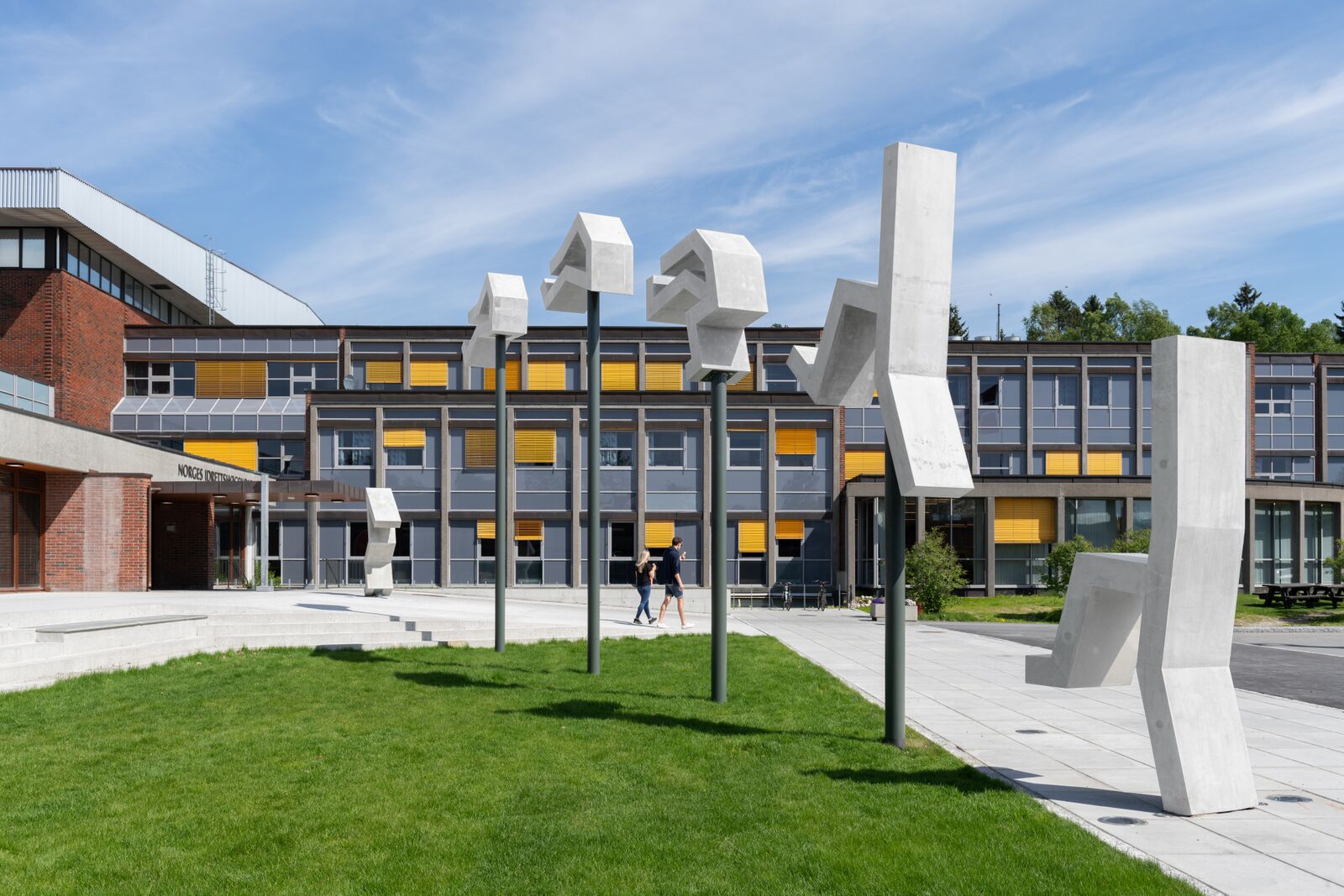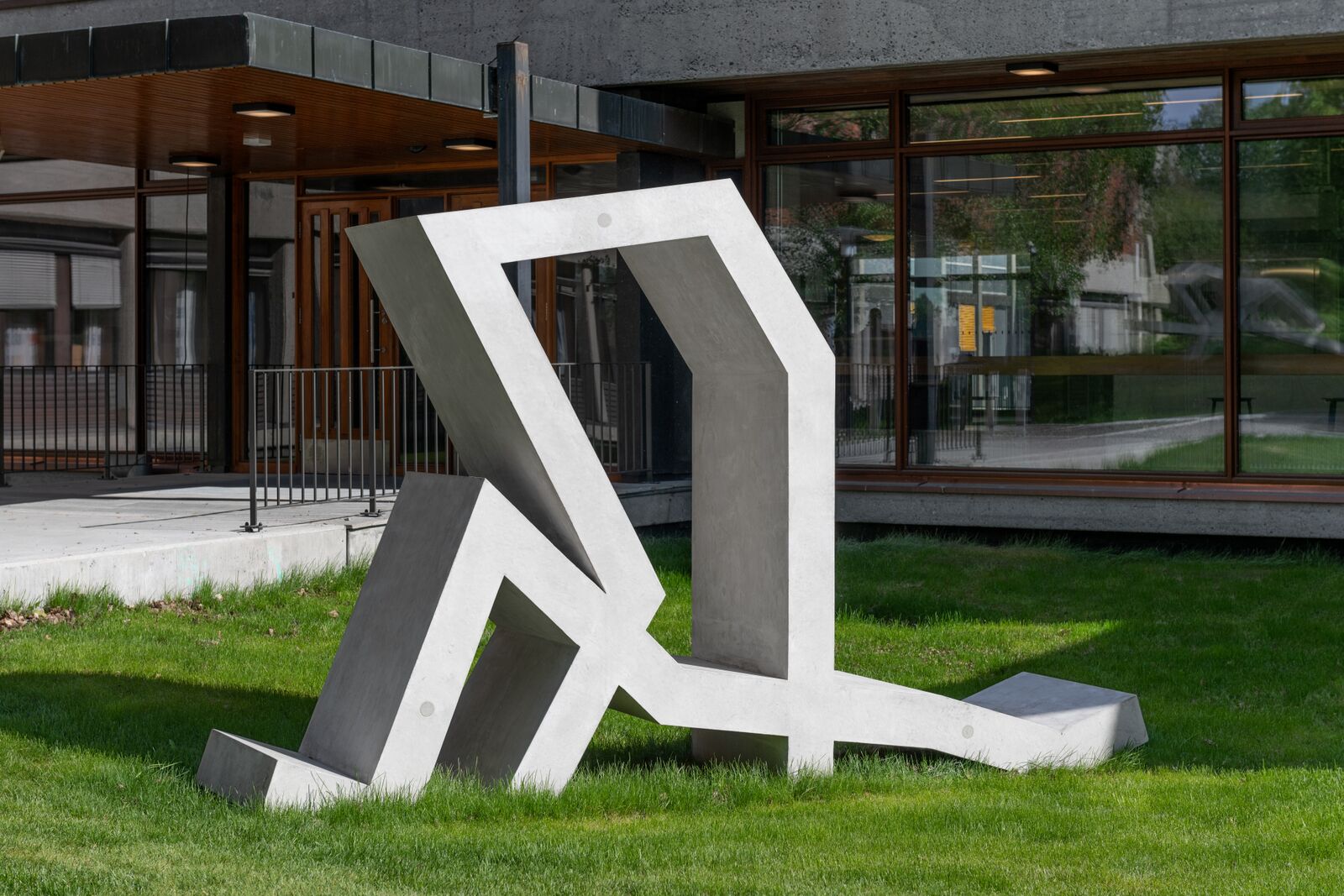





















Your Custom Text Here
The public art at the Norwegian School of Sport Sciences was commissioned by KORO, Norwegian Public Art, and curated by Power Ekroth and Torunn Skjelland.
To download the folder, designed by Blank Blank Grafikk, click here.
The Norwegian School of Sport Sciences (NIH) is a scientific university with a national responsibility for research and education within the field of sport sciences. The school is situated in a complex of buildings, sports facilities and ”pavilions” located by Lake Sognsvann on the outskirts of Oslo. It was designed in 1965 by the architectural firm Pran and Torgersen, with the type of modernistic features and materials typical of the time. During 20152018, the buildings underwent a major refurbishment. KORO, Public Art Norway, was responsible for the new artworks installed at the school.
Two major art projects were produced specifically for the school, and are site specific. One comprises a work by the Norwegian artist Børre Sæthre. This is installed indoors, within a corridor connecting the main building to a pavilion.
The other project is outdoors and consists of two series of largescale sculptures: on the plaza in front of the main entrance, we find Locomotion; and spread out behind the school, we find Wrestlers. Both series of sculptures were produced by Dutch artist duo PolyLester (Gabriel Lester & Martine Vledder). In addition to these two major art projects, new artworks by, among others, artists Katja Høst, Andreas Lærum, Hanna Sjöstrand and Lotta Antonsson were acquired for the school.
LOCOMOTION BY POLYLESTER:
Images by Istvan Virag, Torunn Skjelland and Power Ekroth
Locomotion is a series of sculptures inspired by the origins of sports, as a derivative of both play and hunting tactics. Historical analysis of movement through photography, forms, volumes and arrangements have been extracted. The sculptures reference the experience and science of sports and movement live, recorded, slowed down, paused, re-played and viewed from multiple perspectives at once.
Seeking to visibly relate to the modernist architecture of the site, its specific usage of materials and volumes, the sculptures have been realized in matching concrete.
At the front of the school a long jump is visualized a series of elevated sculptures. Landing at the entrance of the school, the sequence expresses a leap of faith in education, sports and life itself.
At the back the wrestlers are scattered over the rocky landscape. Here the sequence of sculptures becomes a work of true land art and proposes the interaction between two characters.
UNTITLED (RANDOMIZED MOTION TRACKER), 2017
by BØRRE SÆTHRE
A large number of lighting fixtures have been installed by the artist Børre Sæthre along the ceiling of the long corridor that runs between the main building and some of the gymnasiums. The RGBLED lighting fixtures, which are integrated into the ceiling, are programmed in a number of different sequences to create a ripple of movement. The sequences are directly inspired by motion patterns from various sports, such as butterflystroke in swimming or figure skating. This feature gives the work a direct relationship with the building’s daily users, since motion is the very starting point for all research and activity at the School of Sport Science.
The corridor itself has windows along both sides. Although it is bright during the day, the LED lights still manage to shine brightly. During the hours of darkness, the artwork can be seen through the windows from a great distance outside the compound.
A large number of students, visitors and staff pass through the corridor each day. Most of the time the corridor is used merely as a means for getting from one place to another. But as it is a calm space, it is also sometimes used as a type of recreational space: a space to be alone or to have an informal meeting. Because no other organized activities occur there, it is an ideal place for a contemplative art experience, which hopefully will stimulate the visitor to imagine the types of motion that may be represented by the lighting sequences.
As each of the RGBLED fittings includes 180 diodes in the colors red, green and blue, the installation can create millions of different colors and nuances of light. The artist has said that the installation refers to the rather loud, or garish, colours used in sports – neon colors for instance. The repeating linear pulse of light that represents movement gives the building a colourful pulse of its own.
The public art at the Norwegian School of Sport Sciences was commissioned by KORO, Norwegian Public Art, and curated by Power Ekroth and Torunn Skjelland.
To download the folder, designed by Blank Blank Grafikk, click here.
The Norwegian School of Sport Sciences (NIH) is a scientific university with a national responsibility for research and education within the field of sport sciences. The school is situated in a complex of buildings, sports facilities and ”pavilions” located by Lake Sognsvann on the outskirts of Oslo. It was designed in 1965 by the architectural firm Pran and Torgersen, with the type of modernistic features and materials typical of the time. During 20152018, the buildings underwent a major refurbishment. KORO, Public Art Norway, was responsible for the new artworks installed at the school.
Two major art projects were produced specifically for the school, and are site specific. One comprises a work by the Norwegian artist Børre Sæthre. This is installed indoors, within a corridor connecting the main building to a pavilion.
The other project is outdoors and consists of two series of largescale sculptures: on the plaza in front of the main entrance, we find Locomotion; and spread out behind the school, we find Wrestlers. Both series of sculptures were produced by Dutch artist duo PolyLester (Gabriel Lester & Martine Vledder). In addition to these two major art projects, new artworks by, among others, artists Katja Høst, Andreas Lærum, Hanna Sjöstrand and Lotta Antonsson were acquired for the school.
LOCOMOTION BY POLYLESTER:
Images by Istvan Virag, Torunn Skjelland and Power Ekroth
Locomotion is a series of sculptures inspired by the origins of sports, as a derivative of both play and hunting tactics. Historical analysis of movement through photography, forms, volumes and arrangements have been extracted. The sculptures reference the experience and science of sports and movement live, recorded, slowed down, paused, re-played and viewed from multiple perspectives at once.
Seeking to visibly relate to the modernist architecture of the site, its specific usage of materials and volumes, the sculptures have been realized in matching concrete.
At the front of the school a long jump is visualized a series of elevated sculptures. Landing at the entrance of the school, the sequence expresses a leap of faith in education, sports and life itself.
At the back the wrestlers are scattered over the rocky landscape. Here the sequence of sculptures becomes a work of true land art and proposes the interaction between two characters.
UNTITLED (RANDOMIZED MOTION TRACKER), 2017
by BØRRE SÆTHRE
A large number of lighting fixtures have been installed by the artist Børre Sæthre along the ceiling of the long corridor that runs between the main building and some of the gymnasiums. The RGBLED lighting fixtures, which are integrated into the ceiling, are programmed in a number of different sequences to create a ripple of movement. The sequences are directly inspired by motion patterns from various sports, such as butterflystroke in swimming or figure skating. This feature gives the work a direct relationship with the building’s daily users, since motion is the very starting point for all research and activity at the School of Sport Science.
The corridor itself has windows along both sides. Although it is bright during the day, the LED lights still manage to shine brightly. During the hours of darkness, the artwork can be seen through the windows from a great distance outside the compound.
A large number of students, visitors and staff pass through the corridor each day. Most of the time the corridor is used merely as a means for getting from one place to another. But as it is a calm space, it is also sometimes used as a type of recreational space: a space to be alone or to have an informal meeting. Because no other organized activities occur there, it is an ideal place for a contemplative art experience, which hopefully will stimulate the visitor to imagine the types of motion that may be represented by the lighting sequences.
As each of the RGBLED fittings includes 180 diodes in the colors red, green and blue, the installation can create millions of different colors and nuances of light. The artist has said that the installation refers to the rather loud, or garish, colours used in sports – neon colors for instance. The repeating linear pulse of light that represents movement gives the building a colourful pulse of its own.